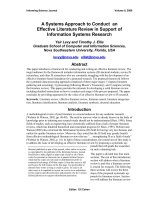Lecture A systems approach to small group interaction (8/e): Chapter 7 - Stewart L. Tubbs
Bạn đang xem bản rút gọn của tài liệu. Xem và tải ngay bản đầy đủ của tài liệu tại đây (685.12 KB, 26 trang )
CCHH AAPP TT EE RR
7
Conflict Management
Stewart L. Tubbs
McGrawHill
© 2004 The McGrawHill Companies, Inc. All rights reserved.
Slide 2
Conflict Management
•
•
•
•
•
•
•
•
•
McGrawHill
Glossary
Case Study
Sources of Conflict
Desirability of Conflict
Types of Conflict
Undesirability of Conflict
Game Theory
Toward Conflict Management
The Systems Approach
© 2004 The McGrawHill Companies, Inc. All rights reserved.
Slide 3
Glossary
• Conflict of Feelings—when people’s ideas come
into conflict, the participants often begin to have negative
feelings toward one another. These conflicts of feelings can
damage the group’s functioning.
• Conflict Grid—a model of conflict management
developed by Robert Blake and Jane Srygley Mouton. It is
a framework for developing conflict management skills.
McGrawHill
© 2004 The McGrawHill Companies, Inc. All rights reserved.
Slide 4
Glossary
• Conflict of Ideas—many ideas are generated in group
discussions. Sometimes different people’s ideas may
conflict. It is important to remember that a variety and
diversity of ideas is usually desirable in the process of
problem solving.
• Conflict Management—the ability to manage
conflict so that there is a healthy conflict of ideas without
the unhealthy conflict of feelings.
McGrawHill
© 2004 The McGrawHill Companies, Inc. All rights reserved.
Slide 5
Case Study
Conflict in the Shipping Department
1. What would you have done if you had been Beth in this
case?
2. How realistic does this case seem based on your
experience?
3. What would you have done differently if you had been
Beth’s supervisor?
4. Are there any other suggestions or recommendations
that you have for instances like this that happen at
work?
5. What material in this chapter can help prepare you for
dealing with such instances?
McGrawHill
© 2004 The McGrawHill Companies, Inc. All rights reserved.
Slide 6
Sources of Conflict
• Conflict exists whenever incompatible
activities occur.
– Conflicts may originate from a number of
different sources, including:
• Differences in information, beliefs, values, interests,
or desires.
• A scarcity of some resource.
• Rivalries in which one person or group competes
with another.
McGrawHill
© 2004 The McGrawHill Companies, Inc. All rights reserved.
Slide 7
Desirability of Conflict
• Many writers believe that conflict in a group
is desirable.
McGrawHill
© 2004 The McGrawHill Companies, Inc. All rights reserved.
Slide 8
Types of Conflict
• Conflict of ideas
– Dooley and Fryxell (1999) found that conflict of
ideas at the early stage of decision making (idea
formulation) was desirable.
– That same conflict sometimes caused problems
at a later stage when the ideas actually had to
implemented.
• Conflict of feelings (often called personality
conflict)
McGrawHill
© 2004 The McGrawHill Companies, Inc. All rights reserved.
Slide 9
Types of Conflict
• Opposition and Support
McGrawHill
© 2004 The McGrawHill Companies, Inc. All rights reserved.
Slide 10
Undesirability of Conflict
• Conflicts are often hard to keep under
control once they have begun.
– There is a definite trend toward escalation and
polarization.
– Once conflict escalates to a point at which it is
no longer under control, it almost always yields
negative results.
McGrawHill
© 2004 The McGrawHill Companies, Inc. All rights reserved.
Slide 11
Game Theory
• Game theory puts people into the mixed
motive situation.
– Covey (1990) in The Seven Habits of Highly
Successful People refers to the scarcity
mentality versus the abundance mentality.
• The scarcity mentality leads us to resent the success
of others.
• The abundance mentality allows us to think of
situations in which everybody can win.
McGrawHill
© 2004 The McGrawHill Companies, Inc. All rights reserved.
Slide 12
Toward Conflict Management
• Blake and Mouton (1970) have proposed a
scheme whereby we can try to avoid
winlose situations and, when possible,
apply a winwin approach.
– The 1,1 style is the handsoff approach, also
called avoidance.
– The 1,9 position, also called accommodation, is
excessively personoriented.
McGrawHill
© 2004 The McGrawHill Companies, Inc. All rights reserved.
Slide 13
Toward Conflict Management
• Blake and Mouton (1970) . . . (continued)
– The 5,5 position represents a willingness to
compromise.
– The 9,1 is the bullheaded approach, also called
competing.
– The optimum style for reducing conflict is the
9,9 approach, also called collaboration.
McGrawHill
© 2004 The McGrawHill Companies, Inc. All rights reserved.
Slide 14
Toward Conflict Management
• Borisoff and Victor (1998) argue that the
best strategy for conflict management
(negotiation) depends on the desired
outcome.
– Unilateral negotiation strategies
• They include:
–
–
–
–
McGrawHill
The trusting collaboration strategy.
The open subordination strategy.
The firm competition strategy.
The active avoidance strategy.
© 2004 The McGrawHill Companies, Inc. All rights reserved.
Slide 15
Toward Conflict Management
• Borisoff and Victor (1998) . . . (continued)
– Interactive negotiation strategies
•
•
•
•
•
•
•
•
•
McGrawHill
Trusting collaboration
Principled negotiation
Firm competition
Soft competition
Open subordination
Focused subordination
Active avoidance
Passive avoidance
Responsive avoidance
© 2004 The McGrawHill Companies, Inc. All rights reserved.
Slide 16
Toward Conflict Management
• Fisher, Ury, and Patton (1991) outline four
principles that compose principled
negotiation.
–
–
–
–
McGrawHill
Separate the people from the problem.
Focus on interests, not positions.
Invent options for mutual gain.
Seek objective criteria.
© 2004 The McGrawHill Companies, Inc. All rights reserved.
Slide 17
Toward Conflict Management
• Tubbs, Kryska, and Cooper (1997) propose
that one frequent source of conflict is the
leadership struggle between superior and
subordinate in decision making.
– The Continuum of DecisionMaking Behavior
has been described as including four styles of
decision making:
•
•
•
•
McGrawHill
Tells
Sells
Consults
Joins
© 2004 The McGrawHill Companies, Inc. All rights reserved.
Slide 18
Toward Conflict Management
• Conflict resolution seems to improve as we
engage in certain behaviors.
– Set the stage for dialogue.
– Disengage your flightfight response.
– State clearly and without anger, your needs and
selfinterests, and listen carefully to those
expressed by others.
– Look below the surface of what is being said.
– Separate the person from the problem.
McGrawHill
© 2004 The McGrawHill Companies, Inc. All rights reserved.
Slide 19
Toward Conflict Management
• Conflict resolution . . . (continued)
– Brainstorm all potential solutions to your
conflict.
– Discuss collaboratively rather than aggressively.
– Use informal problem solving, mediation, and
other conflict resolution techniques.
– Let go of your judgments about the others and
focus instead on improving your own skills at
handling their difficult behaviors.
McGrawHill
© 2004 The McGrawHill Companies, Inc. All rights reserved.
Slide 20
Toward Conflict Management
• Conflict resolution . . . (continued)
– Don’t surrender just so the conflict will go
away.
– Recognize the larger organizational and social
issues that express themselves through conflict.
– Search for completion.
– Modify the agreement if necessary.
(adapted from Cloke and Goldsmith, 2000, pp. 1418).
McGrawHill
© 2004 The McGrawHill Companies, Inc. All rights reserved.
Source: Adapted from Cloke and Goldsmith, 2000, pp. 1418).
Slide 21
Toward Conflict Management
• Diane Yale (1988) outlines three approaches
to conflict that occur in the form of
metaphor.
– The competitive, adversarial metaphor
• Often results in a winner and loser in the resolution
process.
– The problemsolving metaphor
• If your [conflict] is focused on problemsolving,
everything that comes at you . . . is seen as a
problem or a solution.
– The creative orientation metaphor
• Brings an innovative quality to group conflict
resolution.
McGrawHill
© 2004 The McGrawHill Companies, Inc. All rights reserved.
Slide 22
Toward Conflict Management
• Blake and Mouton’s Conflict Grid
McGrawHill
Source: Reproduced by permission from Robert R. Blake and Jane Syngley Mouton. “The Fifth Achievement.”
© 2004 The McGrawHill Companies, Inc. All rights reserved.
Journal of Applied Behavioral Science 6(4), 1970..
Slide 23
Toward Conflict Management—
Practical Tips
Walker and Harris (1995) offer the following
practical tips for implementing the 9,9 style.
Encouraging behavior occurs when a team
member:
1. Avoids feelings or perceptions that imply the other
person is wrong or needs to change.
2. Communicates a desire to work together to explore a
problem or seek a solution.
3. Exhibits behavior that is spontaneous and destruction
free.
McGrawHill
© 2004 The McGrawHill Companies, Inc. All rights reserved.
Slide 24
Toward Conflict Management—
Practical Tips
Walker and Harris . . . (continued)
4. Identifies with another team member’s problems, shares
feelings, and accepts the team member’s reaction.
5. Treats other team members with respect and trust.
6. Investigates issues rather than taking sides on them.
– The same principles can be applied to negotiating with
others outside your team, or with a supplier or
customer (p. 102).
McGrawHill
© 2004 The McGrawHill Companies, Inc. All rights reserved.
Slide 25
Toward Conflict Management
• A Continuum of DecisionMaking Behavior
McGrawHill
Source: From Stewart L. Tubbs. Empowerment (Ann Arbor, Mich.: UTrain, Inc., 1993), pp 59. Adapted from R. Tannenbaum and
© 2004 The McGrawHill Companies, Inc. All rights reserved.
H.W. Schmidt. “How to Choose a Leadership Pattern,” Harvard Business Review MarchApril, 1958.









